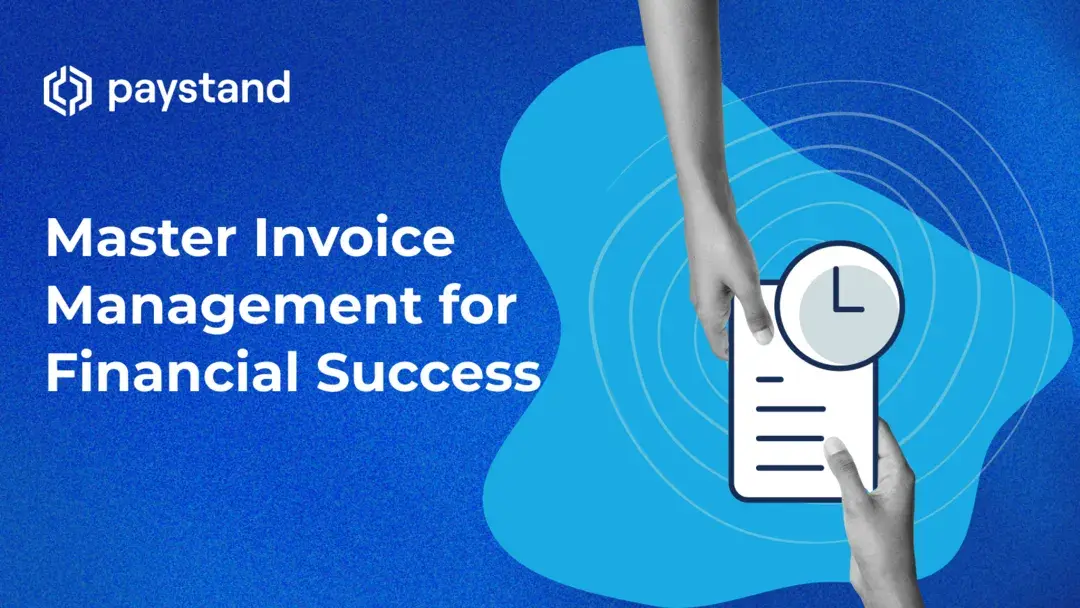Master Invoice Management for Financial Success

Table of Contents
- What is invoice management?
- How the invoice management process works
- How to manage invoices efficiently
- Benefits of using an invoice management system
- Comparing invoice management solutions
- Overcoming common invoice management challenges
- Streamline your invoice management with Paystand
Key Takeaways
- Efficient invoice management drives cash flow, improves financial forecasting, and strengthens relationships with vendors and customers.
- Automating invoice processes reduces errors, speeds up workflows, and improves accuracy, freeing resources for strategic tasks.
- Implementing an invoice management system automates follow-ups, integrates payment gateways, and enhances cash flow visibility.
- Monitoring performance metrics, like DSO, helps identify bottlenecks and optimize invoice management strategies.
- Invoice management systems improve efficiency, enhance cash flow, provide real-time visibility, ensure compliance, and reduce costs.
Efficient invoice management isn’t just about keeping the books in order. It’s a critical driver of cash flow, financial forecasting, and customer and vendor relationships. For financial controllers, mastering the art of handling invoices can streamline operations, minimize errors, and optimize accounts receivable management. But how does this process work, and what tools can transform it from a manual chore into a strategic advantage?
This guide delves into invoice management, exploring invoices, their lifecycle, and how to overcome common challenges. Whether you're curious about leveraging automation or understanding the nuances of accounts receivable management, read on to uncover actionable insights and proven strategies to enhance your financial workflows.
What Is Invoice Management?
Invoice management encompasses the end-to-end handling of invoices—from creation and approval to payment tracking, reconciliation, and recordkeeping. It applies to accounts payable (invoices a business receives from suppliers) and accounts receivable (invoices issued to customers).
Businesses prioritizing effective invoice management reduce payment delays, strengthen vendor and customer relationships, and improve financial forecasting. For a breakdown of what invoices are, their components, and how they differ, see our explanation of what an invoice is.
How the Invoice Management Process Works
Invoice management is crucial for businesses to ensure timely payments, accurate records, and healthy cash flow. Key steps in this process include creating, sending, tracking, and reconciling invoices, which can be streamlined to improve financial efficiency.
1. Invoice Creation
Invoices are generated to bill customers for goods or services. This stage includes defining key invoice elements, such as the invoice number, client details, itemized charges, payment terms, and due date. Many businesses use accounting software or enterprise resource planning (ERP) platforms to automate invoice creation, ensuring accuracy and consistency.
2. Invoice Submission
Invoices are traditionally sent to customers by mail but increasingly via email or digital platforms. Many businesses now use software to automate this process, ensuring faster delivery and better tracking.
3. Invoice Tracking and Follow-up
Tracking outstanding invoices ensures timely payment and identifies delinquent accounts. Payment reminders and follow-up communications, such as dunning letters, are critical for managing overdue payments. Automated systems notify customers as due dates approach and escalate reminders if payment delays persist.
4. Payment and Reconciliation
Once payments are received, they must be matched to their corresponding invoices to ensure accurate records. Automation tools simplify reconciliation by automatically applying payments to outstanding invoices.
5. Record keeping and Auditing
Maintaining organized, accessible invoice records is vital for compliance and financial audits. Modern invoice management systems store documents digitally, enabling easy retrieval and providing robust reporting capabilities.
How to Manage Invoices Efficiently
1. Automate Invoice Processes
Manual invoice handling is error-prone and time-consuming. Automation software generates invoices, sends reminders, and tracks payments. Solutions like NetSuite, Xero, and WooCommerce offer built-in automation that improves accuracy and frees up resources for more strategic tasks.
2. Standardize and Use Invoice Templates
Standardized templates ensure consistency across all invoices. Many ERP platforms provide customizable templates, enabling businesses to maintain brand consistency while simplifying invoicing creation.
3. Implement Invoice Payment Management Systems
An invoice management tool provides real-time payment status updates, automates follow-ups, and integrates with payment gateways to speed up transactions. Advanced systems also generate analytics to help optimize cash flow and forecast revenue.
4. Offer Multiple Payment Options
Making it easy for customers to pay is key to reducing late payments. Offering digital payment methods like ACH transfers, credit cards, and online payment portals simplifies the process and encourages faster settlements.
5. Monitor Invoice Performance Metrics
Tracking KPIs such as days sales outstanding (DSO) helps businesses gauge the effectiveness of their invoice management process. Regular reviews allow companies to identify bottlenecks and refine their strategies.
Benefits of Using an Invoice Management System
Investing in a dedicated invoice management system provides several advantages:
- Improved efficiency: Automation reduces repetitive tasks, speeds up processing, and minimizes human errors.
- Enhanced cash flow: Timely reminders and digital payment options help reduce late payments and improve cash flow predictability.
- Increased visibility: Dashboards and real-time reporting offer insights into outstanding balances and payment trends.
- Compliance and security: Systems store invoices securely and provide an audit trail, ensuring compliance with regulations.
- Cost savings: Reducing manual labor and errors saves both time and money.
Comparing Invoice Management Solutions
Here’s a comparison of popular platforms that enhance the invoicing process:
| Platform | Key Features | Ideal For |
|---|---|---|
| Xero | Automated invoicing, payment tracking, multi-currency support | Small to mid-sized businesses |
| WooCommerce | Integrated invoicing for online transactions, customizable templates | eCommerce businesses |
| NetSuite | Comprehensive ERP features, automated reminders, real-time visibility | Enterprises and growing businesses |
Each platform addresses specific invoicing needs. For example, Xero’s intuitive design and automation suit smaller businesses looking to streamline payments. WooCommerce’s integration with eCommerce simplifies online invoicing, while NetSuite’s robust ERP capabilities suit complex financial environments.
Overcoming Common Invoice Management Challenges
Despite automation, businesses face hurdles disrupting invoicing and payment workflows, which affect cash flow, customer relationships, and financial reporting. Identifying common issues and implementing solutions can mitigate their impact and maintain efficient operations. Here are frequent obstacles and strategies to address them:
- Late Payments: Sending automated reminders and offering payment options encourages timely payments.
- Data Entry Errors: Using pre-filled templates and automated solutions reduces manual input and errors.
- Tracking Delays: Real-time tracking systems help finance teams stay updated on invoice statuses.
Streamline Your Invoice Management with Paystand
Modern invoice management demands more than manual processes—it requires automation, integration, and real-time visibility to stay ahead. Paystand revolutionizes accounts receivable management by offering a cloud-based solution that automates invoicing, accelerates payment collections, and delivers valuable insights into cash flow. With digital payment options, automated reminders, and seamless integration with platforms like NetSuite, Paystand empowers businesses to eliminate inefficiencies and unlock financial growth.
Ready to transform your invoicing process and experience the benefits firsthand? Book a demo today and see how Paystand can elevate your financial operations.





